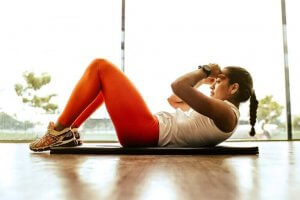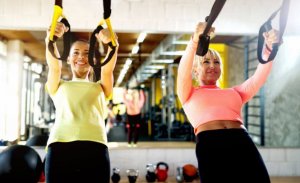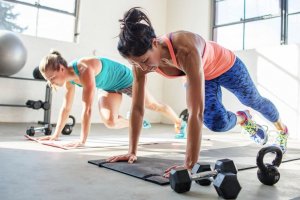Conditioning and Strength Training at Home

One of the main reasons why people don’t exercise is that they say they don’t have time. Many times, either because of school or class, a busy day, or simply because the weather isn’t great, it can be hard to go to the gym. Therefore, in this article, we’ll show you how you can do conditioning and strength training at home.
Here, we’ll show you several alternatives for your training- if you’re not exercising at all, it can also be a good way to start- to work on your strength and conditioning. The best part is that you don’t even have to leave your house.
Bodyweight exercises for training at home
Strength training with bodyweight is, as it sounds, using the weight of your body to workout. Therefore, you don’t need to use any materials.
This type of physical exercise helps burn fat and increase muscle mass. By practicing them, you’ll improve your physical condition, endurance, strength, and speed. In fact, this study by Pérez-López, Santiago, Merino, Sánchez, Valverde & Cerrato from 2016 confirms it.
There are lots of bodyweight exercises that you can do at home. For example:
- Push-ups: chest, triceps, shoulders, and core.
- Tricep dips: triceps and deltoids.
- Squats: lower limbs.
- Glute bridges: gluteal and hamstrings.
- Split squats: lower body.
- Planks: abdominals and spinal erectors.

- Side planks: obliques, glutes, abductors.
- Crunches: straight abdominals.
- Abdominal hold.
- Crunches: obliques.
Go one step further with elastic resistance bands
If you want to increase the intensity while training at home, you could add elastic resistance bands. You can buy these at a low cost compared to other training equipment, and they’re easy to transport.
Resistance bands can offer a wide variety of exercises to improve strength and physical condition. This research by Carreño & Garzón in 2017 expresses it.
When buying and using some bands, keep in mind that not all are the same. They have different characteristics such as width, length, material, grip, etc.
Also, they have different resistances. The greater the resistance, the more force you need to exert to exercise. Normally, the color of the band indicates how much resistance it has.
Another characteristic of elastic bands is that the resistance increases as you stretch them. This way, depending on the athlete’s physical conditions and the exercises, you might want to use one elastic band over another.
Exercises while training at home with elastic bands
Here, we’ll show you some exercises that you can do with elastic bands. Keep in mind that some of these need an anchor on a door. Usually, these come with the bands when you purchase them.
- Close row: dorsal, biceps, and posterior deltoids. You could do this sitting down, using your feet as a support point, or an anchor placed on the door.
- Chest press: pecs, triceps, and anterior deltoids. As in the previous exercise, we recommend a door anchor or pole-type bracket.
- Shoulder press: medium deltoids and triceps.
- Lateral raises: medium deltoids.
- Pallof press: core. Anchors or a pole are recommended.
- Leg abduction: hip abductors.

- Leg adduction: hip adductors.
- Knee banded squats: lower body, focusing on the abductor muscles.
- Lateral band walks: hip abductors.
- Knee banded glute bridge: glutes and hamstrings.
- Banded bicep curls: biceps.
- Banded tricep extensions: triceps. We recommend using an anchor.
- Banded shoulder rotations: shoulder rotators. It would be best to use a door post or an anchor.
Improve your physical condition with TRX
TRX is another very accessible and interesting material that gives you infinite possibilities to work on your physical fitness. As stated in this study by Zhang (2008), it offers an effective supplement to traditional training methods.
Suspension training is a combination of unique training movements. They are aimed at improving strength, endurance, coordination, flexibility, power, and stability in a single workout.
Unlike the elastic bands, to use TRX, you need to anchor them to a door. Here are some examples of exercises, as well as the muscles they work:
- Squat jump: lower limbs (quadriceps, gluteus, hamstrings, etc.).
- Pistol squat: lower limbs.
- Split squat: lower limbs.
- Chest press: pectorals, triceps, deltoids, and core.
- Close row: latissimus dorsi, biceps, deltoids, and core.
- Open row: latissimus dorsi, rhomboids, deltoids and core.

- Deltoid fly: deltoids, trapezium, rhomboids, infraspinatus and core.
- ‘Y’ deltoid fly: deltoids, trapezium, rhomboids, infraspinatus and core.
- Pullover: pectorals, triceps, latissimus Doris, and abdominals.
- Biceps: biceps and core.
- Triceps: triceps and core.
Use the HIIT method for training at home
Finally, if you don’t have a lot of time, you want to burn calories and you like to finish your workouts feeling tired, the training method you’re looking for is HIIT (High-Intensity Interval Training).
This method consists of repeated sequences for periods of high intensity, followed by various recovery times. The main goal is to boost your metabolism and maximize oxygen consumption.

To do it, you won’t need more than 20-25 minutes, and you don’t need any equipment. In addition, there’s scientific evidence that shows that this method has the same or better results than regular cardio activity, according to Alonso, Fernández, and Gutiérrez (2017).
Work your conditioning and strength training at home!
All of these alternatives are intended to help you stay healthy. We know work and school can be overwhelming, and it can be hard to find time to exercise. However, with these ideas and just a little bit of time every day, you can stay fit and healthy!
One of the main reasons why people don’t exercise is that they say they don’t have time. Many times, either because of school or class, a busy day, or simply because the weather isn’t great, it can be hard to go to the gym. Therefore, in this article, we’ll show you how you can do conditioning and strength training at home.
Here, we’ll show you several alternatives for your training- if you’re not exercising at all, it can also be a good way to start- to work on your strength and conditioning. The best part is that you don’t even have to leave your house.
Bodyweight exercises for training at home
Strength training with bodyweight is, as it sounds, using the weight of your body to workout. Therefore, you don’t need to use any materials.
This type of physical exercise helps burn fat and increase muscle mass. By practicing them, you’ll improve your physical condition, endurance, strength, and speed. In fact, this study by Pérez-López, Santiago, Merino, Sánchez, Valverde & Cerrato from 2016 confirms it.
There are lots of bodyweight exercises that you can do at home. For example:
- Push-ups: chest, triceps, shoulders, and core.
- Tricep dips: triceps and deltoids.
- Squats: lower limbs.
- Glute bridges: gluteal and hamstrings.
- Split squats: lower body.
- Planks: abdominals and spinal erectors.

- Side planks: obliques, glutes, abductors.
- Crunches: straight abdominals.
- Abdominal hold.
- Crunches: obliques.
Go one step further with elastic resistance bands
If you want to increase the intensity while training at home, you could add elastic resistance bands. You can buy these at a low cost compared to other training equipment, and they’re easy to transport.
Resistance bands can offer a wide variety of exercises to improve strength and physical condition. This research by Carreño & Garzón in 2017 expresses it.
When buying and using some bands, keep in mind that not all are the same. They have different characteristics such as width, length, material, grip, etc.
Also, they have different resistances. The greater the resistance, the more force you need to exert to exercise. Normally, the color of the band indicates how much resistance it has.
Another characteristic of elastic bands is that the resistance increases as you stretch them. This way, depending on the athlete’s physical conditions and the exercises, you might want to use one elastic band over another.
Exercises while training at home with elastic bands
Here, we’ll show you some exercises that you can do with elastic bands. Keep in mind that some of these need an anchor on a door. Usually, these come with the bands when you purchase them.
- Close row: dorsal, biceps, and posterior deltoids. You could do this sitting down, using your feet as a support point, or an anchor placed on the door.
- Chest press: pecs, triceps, and anterior deltoids. As in the previous exercise, we recommend a door anchor or pole-type bracket.
- Shoulder press: medium deltoids and triceps.
- Lateral raises: medium deltoids.
- Pallof press: core. Anchors or a pole are recommended.
- Leg abduction: hip abductors.

- Leg adduction: hip adductors.
- Knee banded squats: lower body, focusing on the abductor muscles.
- Lateral band walks: hip abductors.
- Knee banded glute bridge: glutes and hamstrings.
- Banded bicep curls: biceps.
- Banded tricep extensions: triceps. We recommend using an anchor.
- Banded shoulder rotations: shoulder rotators. It would be best to use a door post or an anchor.
Improve your physical condition with TRX
TRX is another very accessible and interesting material that gives you infinite possibilities to work on your physical fitness. As stated in this study by Zhang (2008), it offers an effective supplement to traditional training methods.
Suspension training is a combination of unique training movements. They are aimed at improving strength, endurance, coordination, flexibility, power, and stability in a single workout.
Unlike the elastic bands, to use TRX, you need to anchor them to a door. Here are some examples of exercises, as well as the muscles they work:
- Squat jump: lower limbs (quadriceps, gluteus, hamstrings, etc.).
- Pistol squat: lower limbs.
- Split squat: lower limbs.
- Chest press: pectorals, triceps, deltoids, and core.
- Close row: latissimus dorsi, biceps, deltoids, and core.
- Open row: latissimus dorsi, rhomboids, deltoids and core.

- Deltoid fly: deltoids, trapezium, rhomboids, infraspinatus and core.
- ‘Y’ deltoid fly: deltoids, trapezium, rhomboids, infraspinatus and core.
- Pullover: pectorals, triceps, latissimus Doris, and abdominals.
- Biceps: biceps and core.
- Triceps: triceps and core.
Use the HIIT method for training at home
Finally, if you don’t have a lot of time, you want to burn calories and you like to finish your workouts feeling tired, the training method you’re looking for is HIIT (High-Intensity Interval Training).
This method consists of repeated sequences for periods of high intensity, followed by various recovery times. The main goal is to boost your metabolism and maximize oxygen consumption.

To do it, you won’t need more than 20-25 minutes, and you don’t need any equipment. In addition, there’s scientific evidence that shows that this method has the same or better results than regular cardio activity, according to Alonso, Fernández, and Gutiérrez (2017).
Work your conditioning and strength training at home!
All of these alternatives are intended to help you stay healthy. We know work and school can be overwhelming, and it can be hard to find time to exercise. However, with these ideas and just a little bit of time every day, you can stay fit and healthy!
All cited sources were thoroughly reviewed by our team to ensure their quality, reliability, currency, and validity. The bibliography of this article was considered reliable and of academic or scientific accuracy.
- Alonso-Férnández, D., Fernández-Rodriguez, R., & Gutiérrez-Sánchez, Á. (2017). Effect of a HIIT programme vs. Extensive Continuous Training on inexperienced individuals. Educació Física i Esports, (130), 84-94.
- Carreño Montañez, J. E., & Garzón Casallas, D. E. (2017). Efectos de un programa de fuerza en adulto mayor por medio de la aplicación de trabajos con auto carga y bandas elásticas (Bachelor’s thesis).
- PÉREz-LóPEz, A., Santiago, J. G., Merino, P., Sánchez, C. V., Valverde, I. A., VALVERDE, B. Á., … & Cerrato, D. V. (2016). Beneficios de un programa de ejercicio físico con autocargas y materiales reciclados sobre la composición corporal y la condición física en tercera edad: estudio piloto. Revista Española de Educación Física y Deportes, (413), 21-32.
- Sanchez Contreras, J. E. (2018). Motivos para realizar ejercicio físico y su relación con la obesidad abdominal en estudiantes de la Facultad de Medicina, San Fernando.
- Zhang, F. (2018, December). Effect of TRX Suspension Training on Dorsal Muscle Strength and Isometric Muscle Endurance of Police College Students. In 2018 2nd International Conference on Education Innovation and Social Science (ICEISS 2018). Atlantis Press.
This text is provided for informational purposes only and does not replace consultation with a professional. If in doubt, consult your specialist.








